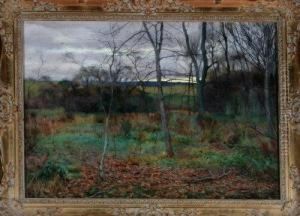Stanley Thompson Paintings
Stanley Thompson, born in 1893 in Toronto, Canada, was not a conventional artist of canvas and paint but an architect of the land. As one of the most influential golf course architects in Canada and a pioneer in North American golf course design, Thompson's legacy is grounded in his naturalistic approach to golf course architecture, which harmonized the rugged beauty of Canada's landscapes with the strategic demands of the game. His career, spanning the early to mid-20th century, was a testament to his vision of integrating the natural environment with the sport of golf, creating courses that were both a challenge to play and a pleasure to experience.
Thompson's education in landscape architecture provided the foundation for his unique approach to golf course design. After serving in World War I, where he was exposed to the landscapes of Europe and the emerging popularity of golf, Thompson returned to Canada inspired to apply his skills to the burgeoning world of golf course architecture. In 1923, he founded Thompson, Cumming, and Thompson, a firm that would leave an indelible mark on the golfing landscape in Canada and beyond.
Throughout his career, Thompson designed or remodeled over 145 courses worldwide, with many in his home country of Canada. His masterpieces include the iconic Banff Springs Golf Course in Alberta, Jasper Park Lodge Golf Course in Alberta, and St. George's Golf and Country Club in Ontario, among others. These courses are celebrated for their seamless integration into the natural landscape, employing the existing topography, vegetation, and water features to challenge and delight golfers. Thompson's designs often featured dramatic bunkering, undulating greens, and strategic layouts that require thoughtful play.
Stanley Thompson's influence extended beyond his own designs. He was a founding member of the American Society of Golf Course Architects in 1947, helping to professionalize the field and mentor the next generation of designers. His commitment to the craft and his visionary approach to design have earned him numerous accolades, including posthumous induction into the Canadian Golf Hall of Fame and the recognition of several of his courses as among the best in the world.
Thompson passed away in 1953, but his legacy lives on through his iconic courses, which continue to be revered by golfers and designers alike. His work not only elevated the game of golf in Canada but also set a benchmark for golf course design worldwide. Stanley Thompson's artistic vision and respect for the natural landscape have left a lasting impact on the sport, making him a true pioneer in the field of golf course architecture.







